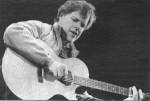Words and Music: Leo Kottke's travels with guitar and voice
Page 2
by Jim Ohlschmidt "If you try to imagine where Leo fits into the history of guitar music, his antecedents would be people like Mauro Giuliani and Agustin Barrios, who were virtuoso composers who broke new ground for the guitar while achieving an enormous popular following in their own time. Leo has done the same thing," says John Stropes, author of Leo Kottke: Eight Songs [Hal Leonard], the most meticulous and informed volume of Kottke transcriptions to date. "We owe him a lot, because he's a model of someone who's not standing still. There aren't many people in our time who have accomplished what he has done and what he continues to do."
Leo playing slide at the Strawberry Music Festival (Photo by Gary Moon) Having spent years mapping the intricacies of Leo's playing, Stropes took a considerable pause before answering the question of what makes Kottke's music so powerful. "Of course there's an extraordinary technique. But there is also a magic to the rhythmic quality of his music. It captivates audiences . It's more than just playing in the groove. I think it's the way he distills American music in an instrumental format on the guitar. That's his genius as a composer, bringing American idioms to solo guitar."
Kottke's landmark collection of acoustic instrumentals released by Takoma Records in 1969, 6 and 12 String Guitar (a.k.a. "the armadillo album"), crystallized Kottke's strikingly original guitar style -- an unprecedented, albeit peculiar, amalgam of blues, bluegrass, classical, and pop music vastly different from the work of other acoustic players who, like Kottke, developed their abilities during folk music's peak in the late 1950's and early '60's. Those who subsequently found a commercially viable niche did so either by virtue of their skills within a more specific traditional genre such as bluegrass, or by molding their original music into a more radio-friendly pop format. Taking a cue from Takoma founder and steel-string guitar pioneer John Fahey, Kottke bypassed both of those options and ultimately created his own genre.
Even more peculiar was Kottke's penchant for the acoustic 12-string guitar, an unwieldy beast of an instrument that at the time only a handful of players such as Pete Seeger, Dick Rosmini, and Fred Gerlach could wrestle into instrumental submission. It was a vintage Gibson B-45 12-string that brought to life most of Kottke's early classics -- "Ojo," "Vaseline Machine Gun," "Crow River Waltz," and others -- on 6 and 12 String Guitar, yet as Kottke recalls, the magical guitar proved to be a cruel trick of fate.
"I had the unbelievable bad luck to find a freak. That Gibson. It was literally anomalous. I don't think there have been any others like that. It was stolen in Portland, Oregon, and I went on an endless search, not for a good 12-string, but to get that sound back." After complaining about his guitar during a show in Los Angeles, Kottke was visited backstage by Dick Rosmini, whose Elektra record Adventures of 6 and 12 String Guitar Kottke loved. Rosmini told him, "You know, it really doesn't matter what guitar you play. It's all to do with your playing," Kottke recalls. "And he picked up this guitar that I had just been whining about and made it sound beautiful. Stunning. He had no [finger] picks on and had no trouble whatsoever making it sound wonderful. Then he left."
The thrust of Rosmini's advice, as Kottke saw it, was to get rid of the fingerpicks. "It took me a long time, " he says. "For a long time I just used a thumbpick, and then one night -- I remember it was in Melbourne -- I got rid of it. It was in a great big hall and it was scary. You know, people have paid to come and hear you and you know it might be really bad; you're gonna have big blisters. Once I around that and got into it, I had different requirements. Taylor was willing to do just about anything I wanted, and I've got a guitar now that works well for me. I'm now hearing what I want to hear when I play that guitar."
Audio & Video | Photo Gallery | Kottke Network | Links | Search | Credits
Home (Frames) | Home (No Frames)
Comments or questions about Leo's web site? Send mail to webmaster@guitarmusic.org.
